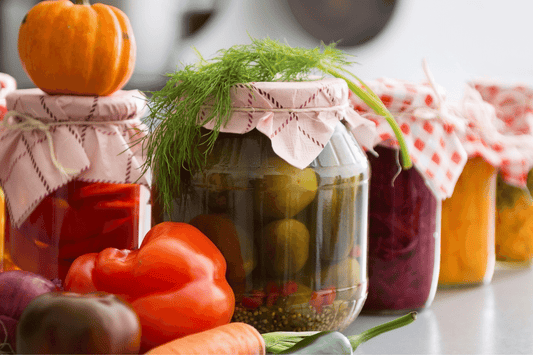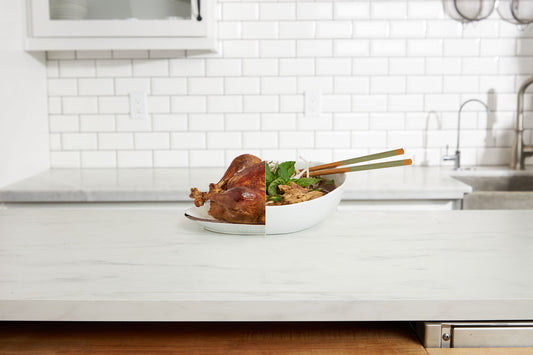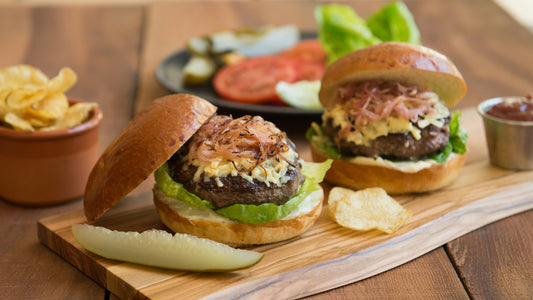By: Christina Chonody - Culinary & Marketing Mastermind, Julian Weisner - Mad Culinary Scientist, and Owen Wyatt - Cue Chef of Chefs and Maker of Amazingly Tasty Recipes
How to Cook Chicken Breast on the Stove: The Basics
You wouldn't set your oven to "Medium" or "Medium-High" to bake your chicken, so why settle for "Medium-High" on your stove? Cooking with precise time and temperature on your stove is the most reliable and effective way to get perfectly cooked meat every single time.

Cooking chicken in a pan is the best way to get a perfectly juicy, tender interior without compromising on the crispy, golden-seared crust.
With precise temperature control you can set your Cue to the right temperature and let the pan do the work. Working with this technology, our culinary scientists have calculated the times and temperatures needed to produce the perfect seared chicken breasts and thighs.
This guide for pan-seared chicken covers everything you need to know about cooking chicken breasts and thighs on your Cue or stove; from timing and temperature guidelines, to prep, searing and serving tips. We'll also explore the importance of thickness, doneness, timing, and temperature.
Converting Temperatures to Traditional Stovetops
Precise temperature control is enabled by the Hestan Cue Smart Cooking System, but if you don't have one on hand, don't worry! You can still use these guides. Simply use the following recommendations to see how precision temperatures convert to the more familiar High, Medium, or Low settings on your stovetop.

Why Cook Chicken in a Pan?
A beautiful pan seared chicken will have achieved a warm golden brown exterior and a moist tender interior, all in less time than it takes to cook a frozen pizza (no hard feelings towards pizza night). Not only is it fast, but pan searing produces all of these great culinary attributes without having to reach for another tool.
- Caramelization? Check!
- Maillard Reaction? Check!
- Crispy on the outside, moist on the inside? Check!
- A one way ticket to flavor town? Check, Check, Check!
Temperature and Timing for Pan-Seared Chicken Breast
Cooking chicken on the stove is the fastest way to get both a perfectly cooked AND seared chicken breast. After testing endless thickness and doneness combinations at countless temperatures, we concluded that the best temperature for pan-seared chicken is 375ºF / 190ºC, or "medium" on your stovetop. This temperature gives us enough time to cook the chicken all of the way through, while producing that golden exterior we are looking for. Now, we just need to adjust the timing to account for thickness and doneness in order to to finesse this bird from pan to plate.
Setting the baseline for temperature allows us to adjust the cooking time down to the second based on the thickness of the chicken breast and your preferred level of doneness.
Download the Time & Temps for Chicken
Minimum Cook Time per Side for Pan-Seared Chicken
| Thickness | Tender & Juicy (m:s) | Firm & Juicy (m:s) |
|---|---|---|
| 1" | 07:30 | 09:15 |
| 1 1/8" | 09:30 | 11:45 |
| 1 1/4" | 11:45 | 14:30 |
The table above is an example of how the minimum cooking time for pan-seared chicken changes based on thickness and doneness. Please note that these times are based on a precise cooking temperature of 375ºF / 190ºC. Set your stovetop to "medium" if you are cooking on a traditional cooktop; however, timing and results may vary.
The Effect of Thickness on Timing and Texture
When cooking meat, our goal is to bring the center of our protein up to a desired temperature- think of the pink center on a medium rare steak. This is true through all techniques, whether we are in an oven, a deep fryer, a water bath, or on the stove. When we pan fry, as the meat gets thicker, say from ½” to 1¼” the center moves further and further away from our heat source (the pan), this means it will take longer and longer for us to bring the center of our meat to our desired temperature. This all may seem basic in theory, but it becomes much more difficult when we try to accurately predict how long this will take.
Most recipes will give you a wide range of cooking times for any food, but we're after precision here because we want to achieve the best results possible, every time. Since Cue will precisely control the temperature for your pan, we can accurately predict how long it will take to cook each side. The only thing you need to know is how far away the center is, or in other words, “How thick is your chicken?”
The following is a list of times for cooking boneless skinless chicken breast and thighs to two different levels of doneness. You may find that you actually prefer your chicken cooked somewhere between or outside of these two targets, but you can still use this chart to help dial in your preference for each thickness.
Temperature and Timing Chart for Cooking Chicken

Tips for Cooking Chicken in a Pan Like a Pro
Before we get cooking, we suggest the following...
- Ensure the surface of your meat is dry to maximize browning.
- Use a good amount of oil to evenly coat the bottom surface of the pan.
- Do not crowd the pan, ensure there is a space between each piece of meat for a better sear.
- Add aromatics for a great way to add a rich depth of flavor.
How to Cook Chicken on the Stovetop, Step by Step
Using the chart above you can determine the proper time (per side) to cook your chicken based on its thickness. Follow the step by step recipe below for perfect results every time.
Ingredients
- 2 Boneless, Skinless Chicken Breasts or Thighs
- Kosher Salt
- Black Pepper
- 2 tbsp Cooking Oil

- Set your Hestan Cue Smart Induction Cooking System to 375ºF / 109ºC in control mode, or adjust the settings to "medium" on your stove if using a traditional cooktop.
- Add two tablespoons of your preferred cooking oil to your pan.
- Measure the thickest part of your chicken. Use the chart to determine the appropriate cook time per side.
- Pat your chicken breasts or thighs with a paper towel to dry thoroughly.
- Season as needed with kosher salt and black pepper.
- Add the chicken breasts or thighs to the pan and set the timer accordingly.
- Flip the chicken and cook for the same amount of time as the first side.
- Remove from the pan and allow to rest for 5 minutes.
FAQs for Cooking Boneless, Skinless Chicken in a Pan
Can I use this guide for my own pan and stove top?
Yes! We’ve provided approximate conversions for the temperature and timing for your current stove top. We can’t promise the same results without the precise temperature provided by the Hestan Cue System, but you can still follow along. Use the recommendations below to see how precision temperatures convert to the more familiar High, Medium or Low settings on your stovetop.

Can I use these times and temperatures to cook chicken with the bone in?
These times and temperatures are specifically formulated for boneless chicken. Let us know if you're interested in seeing a bone-in chicken guide in the future! Download the full Hestan Cue Cooktop Time & Temp Chart for more info on cooking other foods.
When should I season my chicken?
As long as you season the chicken before it goes in the pan, and make sure it is as dry as possible once it gets there, your chicken will be fine.
Can I add aromatics, like thyme, rosemary, or garlic to the pan?
Absolutely, aromatics are a great way to add flavor. We recommend adding aromatics during the last cooking step, baste the aromatic infused oil on top of your chicken during this last step to impart as much of the flavor as possible.
Do I need to baste the chicken?
Since chicken breast and chicken thighs have such irregular shapes, basting can seriously help cook all of the meat as evenly as possible, we highly recommend. When working with either breasts or thighs, you should focus your basting on the thickest sections and their edges. Basting with aromatics in the pan is a restaurant style technique that adds flavor and is sure to impress your friends and family.
Can I cook my chicken straight from the freezer?
Nope, you will need to thaw your chicken first! The times and temperatures listed here are designed for boneless, skinless chicken breasts or thighs that have been tempered or taken directly from the refrigerator.
Can I reheat cooked chicken with these times and temperatures?
Since your chicken is already cooked, it will not need to spend nearly as much time to come back up to the proper temperature. You can set the pan to a moderate low temperature like 325°F, and place the chicken in the pan with a little bit of water. The steam should help reheat your meat faster.
Can I use this guide to cook chicken with the skin on?
Yes–with a few minor adjustments. For skin-on chicken breasts and thighs, you'll want to add a searing step at the start of the cooking process to get an extra crispy, golden finish to the skin. Start by preheating your Hestan Cue pan or traditional cooktop to 425°F / 218°C and sear the skin side for two minutes. Proceed with the remaining steps for boneless, skinless chicken breast or thigh using the temperature and timing chart for your preferred level of doneness.
Does my chicken need to rest after it’s done cooking?
Yes, the Hestan Cue System factors in “rest time”. This means that we calculate how much your chicken will continue to cook out of the pan, and account for that. Consider the rest time an additional cook time, and wait at least 5 minutes before slicing your meat.
What are other great ways to cook chicken breast at home without Cue?
Here's a few of our favorite resources for cooking chicken using other techniques that you might enjoy:
- The Food Lab's Complete Guide to Sous Vide Chicken Breast
- The Kitchn's Top 10 Tips for Grilling Chicken Breast
- Healthy Kitchen 101's Complete Guide to Oven-Baked Chicken Breast
- BONUS! Cook's Illustrated Guide to Roast Chicken (for when you're going whole bird...)
I cooked my chicken sous vide. Can I use the same times and temperatures to sear it when I finish it?
Not quite. After sous vide cooking, you can get an amazing sear with precise time and temperature on your stove, but we don't recommend using the temperature and timing listed in the chicken time and temp chart above because you don’t need to cook your chicken any further, you just need to get a quick sear. Below, we've outlined a few resources for sous vide, searing, and nailing the perfect temp and timing for both.
- Hestan Cue Guided Cooking for ChefSteps Joule. Download the Hestan Cue app and cook with your Joule sous vide immersion circulator through to searing on Cue with the Hestan Cue Sous Vide Collection. #CueTip - you can cook these recipes with your Cue using any sous vide device!
- Check out more from the Cue chefs in our Quick Guide to Searing Sous Vide Proteins
Keep us posted with photos of your experiments and share your results and #CueTips with the community!



